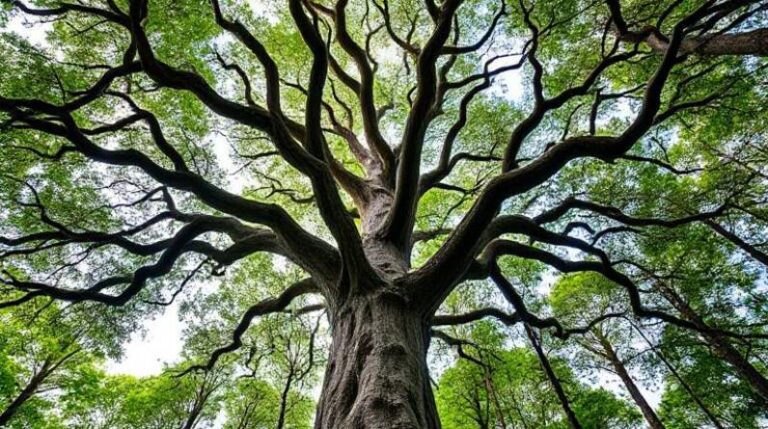Trees are not just the silent guardians of our landscapes — they are dynamic, life-sustaining organisms that shape ecosystems, regulate climate, and nurture biodiversity. While many people recognize a maple or oak in their backyard, few realize the vast spectrum of tree species across the globe. With recent research uncovering over 73,000 distinct tree species, including 9,000 yet to be discovered, the subject of types of trees is far more complex, urgent, and fascinating than previously understood.
This article explores the types of trees from a fresh, global, and conservation-focused perspective, integrating biodiversity, ecological roles, and emerging scientific discoveries.
How Tree Classification Shapes Our Understanding of Nature
Trees are commonly categorized based on several key criteria:
Leaf Behavior: Deciduous vs. Evergreen
- Deciduous Trees: Shed their leaves annually. Examples: Maple, Birch, Oak
- Evergreen Trees: Retain foliage year-round. Examples: Pine, Fir, Spruce
Botanical Families: Conifers and Broadleaf
- Conifers (Gymnosperms): Seed-bearing trees with cones. Example: Eastern White Pine
- Broadleaf (Angiosperms): Produce flowers and fruits. Example: Redbud, Elm
Habitat Adaptation: Where Trees Thrive
- Riparian Trees: Found near water bodies (g., Swamp White Oak)
- Drought-Resistant Trees: Thrive in dry zones (g., Blue Palo Verde)
Regional Icons: How Trees Define Ecosystems Around the World
From the vibrant forests of the Midwest to the cloud forests of the Amazon, trees define the structure and character of natural landscapes.
North America’s Ecological Anchors
| Tree Name | Region | Ecological Role | Notable Trait |
| Sugar Maple | Northeast & Midwest | Supports pollinators, source of syrup | Vibrant fall foliage |
| White Oak | Eastern U.S. | Food for mammals & birds | Lives 200–300+ years |
| Eastern White Pine | Great Lakes | Timber and wildlife shelter | Tallest conifer in Midwest |
| Redbud | Central U.S. | Early food source for pollinators | Heart-shaped leaves, edible flowers |
One Tree, Many Purposes: The Shagbark Hickory
Recognizable by its shaggy bark and tulip-shaped leaves, this tree provides nuts loved by birds and mammals and is valued for its flavorful smoking wood.
South America: The Biodiversity Epicenter
South America is home to 40% of all known tree species, including more than 4,000 yet undiscovered.
- Cecropia Trees in the Amazon host ants that protect them — a rare example of mutual defense.
- The Andean cloud forests feature species found nowhere else, under threat from both logging and warming climates.
Rare and Endangered Trees: A Global Conservation Emergency
A third of all known tree species are considered rare — and that number could rise as undiscovered species are identified.
Examples of Trees at Risk
| Tree | Location | Threat |
| American Chestnut | Eastern U.S. | Chestnut blight |
| Butternut Tree | U.S. & Canada | Fungal canker |
| Whitebark Pine | Western U.S. | Beetle infestation & fungus |
| Florida Torreya | Florida | Declining despite protections |
Rediscovery and Hope: Virginia’s Round-Leaf Birch
Thought to be extinct, this tree was rediscovered in 1975. Only one wild specimen remains — a vivid reminder of how fragile biodiversity can be.
Trees vs. Climate Change: Silent Warriors of Our Planet
Trees do more than shade our parks — they’re climate stabilizers and ecological engineers.
Key Environmental Contributions
- Carbon Storage: Coast redwoods absorb massive CO₂ amounts.
- Urban Cooling: Honey locusts lower temperatures through transpiration.
- Water Regulation: Riparian trees reduce flooding and improve water quality.
Climate-Resilient Trees Leading the Way
| Tree | Adaptation |
| Longleaf Pine | Tolerates storms, fire, and drought |
| Quaking Aspen | Clonal growth enables survival |
| Texas Redbud | Thrives in heat and poor soil |
73,000 Tree Species and Counting: Why This Matters
A global tree census has estimated over 73,000 species, reshaping how we prioritize conservation and research.
The Big Numbers
| Category | Number |
| Total Tree Species Estimated | 73,000 |
| Currently Known Species | ~64,000 |
| Undiscovered Species | ~9,200 |
| Rare Species | Over 24,000 |
| Tree Species in South America | 27,000 |
What This Means for Humanity
- Biodiversity Hotspots identified by this research help target conservation.
- Rare species face the greatest risk from deforestation and climate change.
- Scientific benchmarks guide reforestation and ecological restoration efforts.
How You Can Engage with and Protect Tree Diversity
Five Practical Ways to Make a Difference
- Learn About Your Local Trees
Use tools like Seek or iNaturalist to identify species in your area. - Plant Native Species
Native trees support more wildlife and adapt better to local climates. - Join Tree Planting Events
Urban forestry programs are often seeking volunteers. - Support Reforestation Projects
Donate to nonprofits protecting rare and endangered species. - Practice Responsible Forestry
Avoid moving firewood between regions to prevent spreading invasive pests.
Tree Types
Thinking about “types of trees” today means going beyond backyard shade or pretty fall colors. It’s about:
- Understanding the rich biodiversity of our planet
- Realizing the interconnected roles trees play in every ecosystem
- Committing to conservation action as new species are found and rare ones vanish
Every tree is a chapter in Earth’s ecological story — and it’s up to us to ensure those stories continue to be written.
Frequently Asked Questions (F.A.Q.s)
What are the main types of trees?
Trees are primarily categorized as deciduous (leaf-shedding) or evergreen (year-round foliage), and further grouped into conifers (cone-bearing) and broadleaf (flowering) types.
How many tree species are there on Earth?
A global study estimates about 73,000 tree species, including approximately 9,000 that remain undiscovered.
Why is tree biodiversity important?
Tree diversity supports ecosystems, provides habitat for wildlife, stores carbon, regulates water cycles, and sustains local and global economies.
Which region has the most tree species?
South America leads the world with about 27,000 known tree species, including many that are rare and not yet scientifically described.
What threats do rare tree species face?
Deforestation, invasive pests, habitat loss, and climate change are major threats — especially to rare and localized species.
How can I help conserve tree diversity?
You can plant native species, avoid spreading pests by not moving firewood, support conservation organizations, and learn more about trees in your area using identification apps.
Are any trees still being discovered today?
Yes — scientists estimate over 9,000 tree species have not yet been identified, many of which are likely rare and vulnerable to extinction.
For more insightful articles and the latest updates, keep visiting Hacoo.

